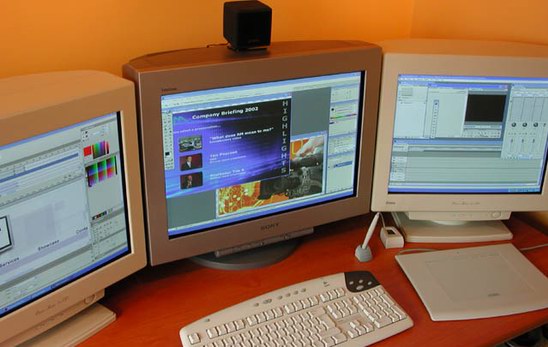|
|
This topic comprises 2 pages: 1 2
|
|
Author
|
Topic: Hardware for Computer DV Production
|
|
|
|
|
|
|
|
|
|
|
|
|
Bobby Henderson
"Ask me about Trajan."

Posts: 10973
From: Lawton, OK, USA
Registered: Apr 2001
|
 posted 09-04-2004 07:49 PM
posted 09-04-2004 07:49 PM




I don't really care at all about the whole Mac versus PC debate, at least when it comes to hardware. The available software and other periphreals available to each platform are the real factors.
This is why I have no problem at all using Windows-based PCs for print graphics and web graphics. Lots of service bureaus and print houses use PCs now. And there's lots of color calibration and profiling tools and other pre-press tools available as well. Several years ago you had to own a Mac to get any of that. Aside from security issues, Windows2000 and XP are certainly a lot more reliable than their earlier counterparts.
The video production thing is different. On the Windows side, the situation is a stupid mess. I'm not happy with any of the offerings there, even the high end ones from companies like Avid. There's always some short-coming here or there. Adobe Premiere Pro is a decent, but not a truly great video editing program. Adobe Encore has a number of bugs and performance issues. It seems like Photoshop and After Effects are really the only great programs from Adobe to use for video. And now Apple's Motion program is a direct competitor with After Effects, and it integrates well with Photoshop.
5.1 surround encoding on the PC is another stupid problem. To do it on a PC, first you must have some audio editor like Vegas or Acid, or a video editor like Premiere Pro. Then you have to blow another $300 to get a Dolby Digital 5.1 encoder plug in. If you want to do DTS encoding for DVD, you're out a cool $2,000 for that SurCode stand-alone app. By comparison, Apple's DVD Studio Pro 3 offers built-in encoding for BOTH Dolby Digital 5.1 and DTS, all for under $500. Apple's production suite, which includes Final Cut Pro HD, DVD Studio Pro 3 and Motion costs $1200. This is probably the best bargain in professional level video production software on the market today.
Apple's Production Suite is the real reason why I would choose a Mac to do video. I don't give a rats ass about how much faster a G5 CPU is than a P4 on some isolated floating point performance test that has nothing to do with real computing performance. The applications are what matters, and Apple has some killer apps in their Production Suite.
| IP: Logged
|
|
Leo Enticknap
Film God

Posts: 7474
From: Loma Linda, CA
Registered: Jul 2000
|
 posted 09-05-2004 05:38 AM
posted 09-05-2004 05:38 AM





So far I haven't come across anything I can't do with Premiere that I could with Avid or Final Cut Pro, and therefore I'm yet to be convinced that the vastly increased cost is worth it. Admittedly I'm not in the broadcast business: mainly what I edit video for is putting together compilations of archive footage for sale to the public on DVD or for public screenings from DVCAM or DVD in venues which can't show film (conference centres, community venues and the like) or where we don't have the money to have 16mm or 35mm viewing copies made from our preservation elements.
For that purpose I'm totally satisfied with Premiere. It's all very well for Final Cut Pro devotees to tell me that it is the 'professional standard', but it costs three times as much, only works on a Mac and can't do anything which I need to do and which Premiere won't.
As for SATA RAIDs or any other type of RAID, a word of warning: unless you configure your discs as a mirrored RAID (i.e. you decide to buy twice as much HDD space as you need for security purposes), then you're at risk of losing the data from all the discs in the RAID if one of them should fail. This is exactly what happened to me about a month ago, and after the knackered HDD was replaced under warranty I formatted my two SATA drives in a standalone base configuration.
And while a 7,200rpm IDE drive is certainly fast enough to capture, I've found that the higher speed of a SATA 150 drive makes a big difference to the seek time when editing, especially if you're working with some pretty big (i.e. tens of gigabytes) DV files, and so would say that what is now only a marginal extra cost is well worth it.
Agreed entirely with Bobby - Encore is a bug-ridden pile of shite, even with the 1.0.1 patch applied. It's bequeathed me more coasters than you'd find in my local pub. A pity, really, as there are no other DVD authoring packages midway in the market between the giveaway crap that comes with burners and the professional packages costing over a grand.
| IP: Logged
|
|
|
|
|
|
|
|
|
|
Daryl C. W. O'Shea
Film God

Posts: 3977
From: Midland Ontario Canada (where Panavision & IMAX lenses come from)
Registered: Jun 2002
|
 posted 09-05-2004 07:30 PM
posted 09-05-2004 07:30 PM





quote: Leo Enticknap
As for SATA RAIDs or any other type of RAID, a word of warning: unless you configure your discs as a mirrored RAID (i.e. you decide to buy twice as much HDD space as you need for security purposes), then you're at risk of losing the data from all the discs in the RAID if one of them should fail.
That's not really that accurate. Any RAID configuration (all but RAID 0) that is based on parity is also fault tolerant. RAID 0 is really only useful for scratch volumes, or non-critical volumes that require a fast read rate and a not-so-fast write rate.
Specifically,
RAID 0: Stripped Array without Fault Tolerance (Pretend0RAID)
Not fault tolerant. Useful for scratch drives requiring faster read than write speed. Also useful for caching servers like Squid.
RAID 1: Mirror & Duplexing (CheapoRAID)
Fault tolerant. Will sustain one or more drive failures. In-efficient. Very few hardware controllers will allow for any read performance increases. Many software controllers will actually see decreases in write performance. OK for any applications requiring high availability, with average performance, like accounting and other financial systems.
RAID 2: Hamming Code ECC Cool RAID
Fault tolerant. Very high performance can be achieved when your data to ECC disk ratio is low. Transaction rate equal to that of a single disk. Simpler than RAID3/4/5 but rather expensive to implement. There aren't any commercially available implementations that I know of. Most people don't even know RAID 2 exists, or if they do what it actually is. I've only ever seen TWO RAID 2 setups.
RAID 3: Parallel Transfer with Parity
Fault tolerant. Requires a minium of three disks. Will sustain the loss of about one drive per parity drive. High read and write transfer speeds. Transaction rate equal to that of a single disk.
RAID 4: Independent Data Disks with Shared Parity Disk Evil RAID
Fault tolerant but a total pain in the ass to recover after a drive failure. High read performance. The worst write performance around.
RAID 5: Independent Data Disks with Distributed Parity Blocks
Fault tolerant. Highest read rates. Average write rates. Rebulding is easier than RAID 4. RAID level which is most familiar to many IT professionals (good for when whoever setup the system disappears and things go bad).
RAID 6: Independent Data Disks with Two Independent Distributed Parity Schemes
Fault tolerant. An extension of RAID 5. Uses an additional set of parity blocks to sustain multiple disk failures. Performance can be as good as RAID 5 for a price. My RAID level of choice.
RAID 10: Mirror and Stripe LameRAID
Fault tolerant. Take a RAID 1 mirrored set and then stripe it with an additional RAID 0 stripe set. Fairly fast, requires 4 drives (inefficient use of drive capacity -- expensive), cheap to implement in hardware or software controllers.
RAID 50: RAID 3 and Stripe RAIDtarded
Fault tolerant. Take a RAID 3 set and then stripe it ala RAID 0. REQUIRES syncronized spindles. Ineffificent use of drive capacity. Don't even bother.
RAID 0+1: Stripe and Mirror 0+1 = 5, well sorta
Fault tolerant. Take a RAID 0 stripe set and mirror it. High performance read. Will sustain ONE drive failure before it becomes as reliable as a RAID 0 set (not fault tolerant). Similar to RAID 5, but not as scalable. Cheaper to implement the controller. OK for small volumes.
| IP: Logged
|
|
|
|
David Buckley
Jedi Master Film Handler
Posts: 525
From: Oxford, N. Canterbury, New Zealand
Registered: Aug 2004
|
 posted 09-05-2004 08:26 PM
posted 09-05-2004 08:26 PM





quote: Daryl C. W. O'Shea
My RAID level of choice
Bit dangerous this; different RAID schemes serve different purposes, and a number of other factors come into play which can make what appears to be the best choice not always the best.
Where a system is random read heavy with several different applications or application types, mirroring almost always gives the best performance. For sequential processing from single application, mirroring does give a great advantage over schemes with less spindles.
But random write performance - boy, thats another story. A fact not appreciated by most IT folk is that a posix compatible "system" in practice can only have a single write outstanding at one time, and the whole system serializes around write performance. How do you get really fast write performance? you need battery backed fault tolerant cacheing disk arrays, to remove the mechanical time out of a write, so a write takes microseconds rather than milliseconds. Factor that in, and the need to write 200% of the data on a mirrored system is insignificant.
Of course, all this costs money, so most people dont have (nor in practice need) anything like high performance writes.
The other important thing with RAID arrays is backup. RAID doesn't remove the need to do proper backups.
From a message in another place entitled "utterly gutted":
I had build a raid 5 system around the promise sx6000 hardware raid card with 6 x superstore caddies (not cheap by any stretch of the imagination) thinking this would keep my data safe. One of the drives failed yesterday - I didn't panic - put in a replacement - the array rebuilt itself and all the lights went green. Rebooted XP and nothing..... the array appeared as un-partitioned space. All the data is gone including all our photos (including those of my newborn daughter) / videos all our documents. The 500 albums I ripped and god knows what else.
Fortunately this story had a somewhat happy ending, about 60% of the stuff was recoved, including all the really important stuff.
| IP: Logged
|
|
|
|
All times are Central (GMT -6:00)
|
This topic comprises 2 pages: 1 2
|
Powered by Infopop Corporation
UBB.classicTM
6.3.1.2
The Film-Tech Forums are designed for various members related to the cinema industry to express their opinions, viewpoints and testimonials on various products, services and events based upon speculation, personal knowledge and factual information through use, therefore all views represented here allow no liability upon the publishers of this web site and the owners of said views assume no liability for any ill will resulting from these postings. The posts made here are for educational as well as entertainment purposes and as such anyone viewing this portion of the website must accept these views as statements of the author of that opinion
and agrees to release the authors from any and all liability.
|

 Home
Home
 Products
Products
 Store
Store
 Forum
Forum
 Warehouse
Warehouse
 Contact Us
Contact Us




 Printer-friendly view of this topic
Printer-friendly view of this topic















